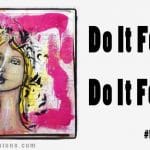I recently finished this painting titled Darkness Within and I thought I’d show you some pictures and tell you about the painting, its themes and what it means to me.
Inspiration

It started with a small thought, that I wanted to study master/famous painters more, especially those whose work speaks to me. The first person who came to mind was Egon Schiele. His work has a depth of feeling that I haven’t experienced with any other paintings. It is something that I wish for in my own art. There is also an element of ugliness, an unrefined rawness associated with being human. I absolutely love Schiele’s work and could look at it for hours!
I have done studies before (as in, trying to faithfully replicate the look of an existing work of art), but it never holds my interest. I can DO it, but I’m not FEELING it. So I wanted to do something with a Schiele painting, without copying it exactly and while putting plenty of myself and my style into the painting.
The Process

The painting “Self Portrait With Hands On Chest” was one that stood out to me, the hands are raw and mesmerizing and I was drawn to the simple almost profile portrait and blue hair. I wanted to try and incorporate a hand into my painting too. I started preparing a background in my A3 art journal. It was a page I had previously started a sketch on with watersoluble crayons, but it wasn’t going anywhere. So I indiscriminately brayered and dragged paint across the whole page, covering everything that was there before.
I started a sketch with a black Stabilo All pencil (my favourite tool for sketches, especially when working on top of an existing background), combining elements of what I could see in Schiele’s painting with ways in which I usually sketch faces. On the one hand I was using the painting as an example, but at the same time I wasn’t worrying about getting a perfect likeness.
There was a rawness to the Schiele hands, but I wanted to push it further. Creating a sort of fairytale witch hand with thin fingers and big knuckles. The hand I ended up drawing fascinates me, and it has shown up in more of my work since then.
The shading on the face closely follows the Schiele painting. It uses a combination of watersoluble crayons, acrylic paint and colour pencils.
Themes

I paint female faces. I have no interest in painting male faces, so that was the biggest divergence from the example. You could say that in some way each portrait I paint is a self-portrait, even if that is not the purpose I set out with. Experiencing being female and femininity is a big theme in my life (and therefore art). I’m especially aware of what it means to be female in our patriarchal society and I’m interested in exploring that experience. The use of pink (often viewed as a ‘girly’ colour) and turquoise is juxtaposed with the use of black, especially black paint applied with a brayer, which adds a rawness.
There is an ugliness and rawness to life that I am keen to explore, but it is something I have struggled to put into my art. This is intertwined with this experience of femininity. As a girl/woman you are expected and praised for espousing and aspiring to certain beauty ideals. A woman is punished (and noticed) for being ugly or doing things in an ugly manner much more harshly than a male person. I want to represent this tension, this dichotomy, the wish to be pretty or make pretty things without disavowing the ugly or raw part of the self.
The subject has her eyes closed. She is looking within, and at the same time not looking at all. She has her eyes closed in order to shield herself, but also in order to have an experience that isn’t available when her eyes are open. Similarly to me as the painter, trying to paint the subject’s eyes open would distract me too much from experiencing the feelings that are able to be felt when the eyes are closed.






